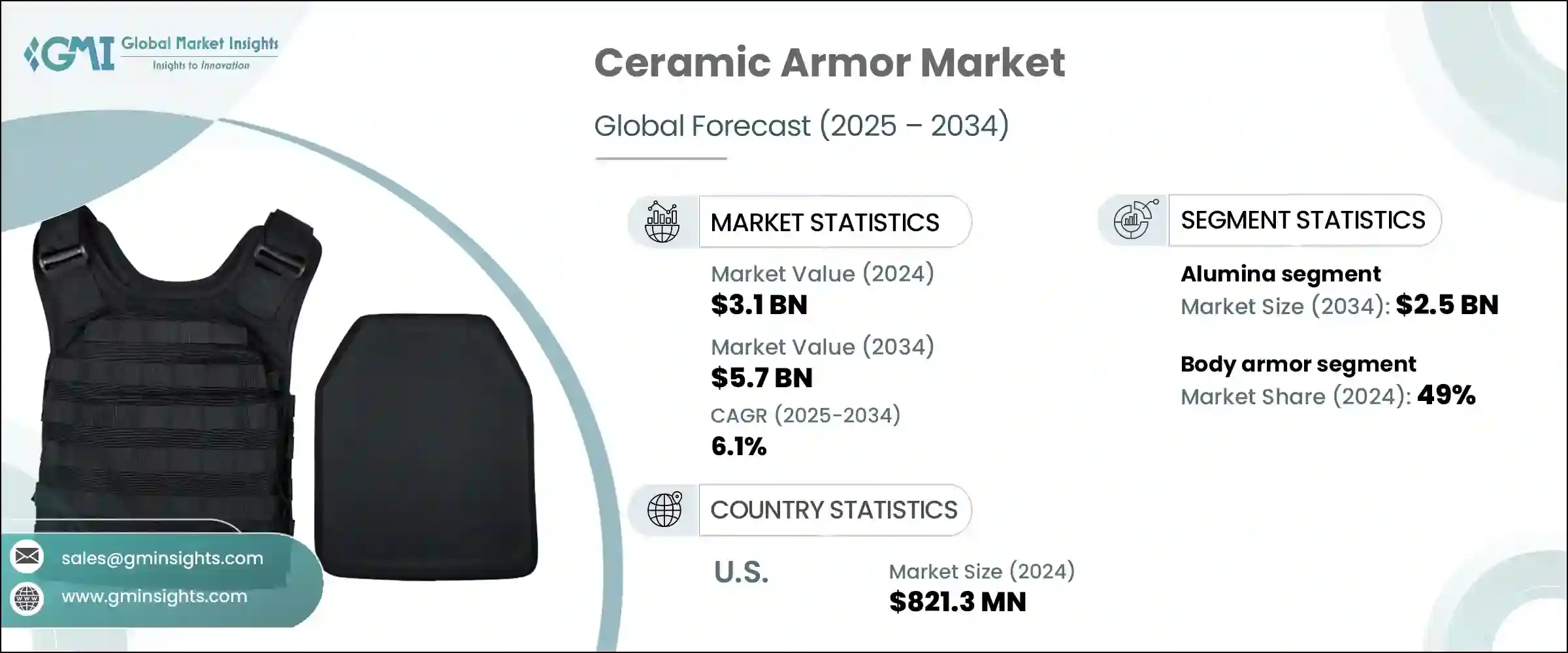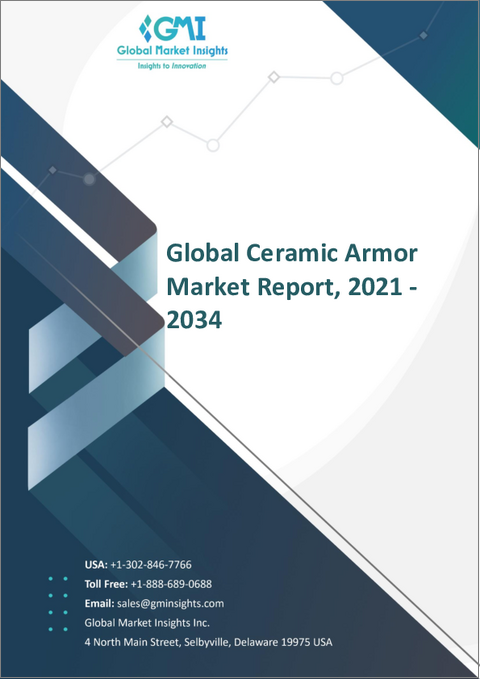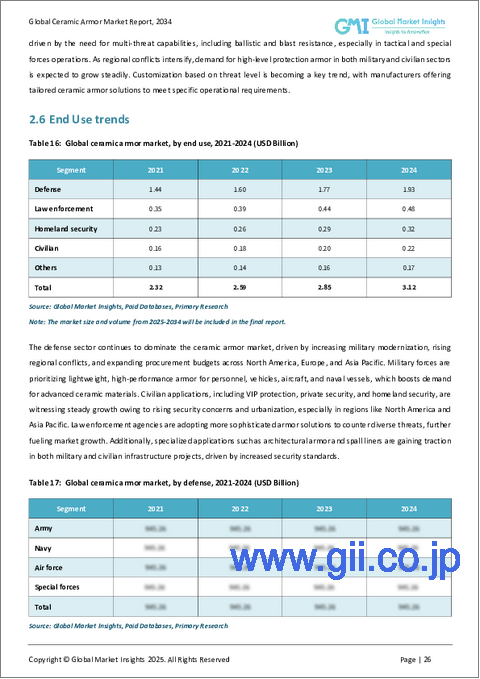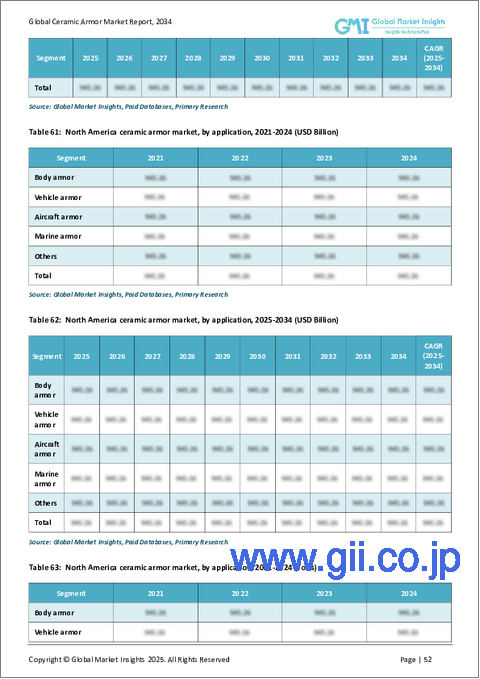|
|
市場調査レポート
商品コード
1773419
セラミック装甲市場の機会、成長促進要因、産業動向分析、2025年~2034年の予測Ceramic Armor Market Opportunity, Growth Drivers, Industry Trend Analysis, and Forecast 2025 - 2034 |
||||||
カスタマイズ可能
|
|||||||
| セラミック装甲市場の機会、成長促進要因、産業動向分析、2025年~2034年の予測 |
|
出版日: 2025年06月19日
発行: Global Market Insights Inc.
ページ情報: 英文 220 Pages
納期: 2~3営業日
|
- 全表示
- 概要
- 目次
セラミック装甲の世界市場は、2024年には31億米ドルと評価され、CAGR 6.1%で成長し、2034年には57億米ドルに達すると推定されています。
この上昇の背景には、防衛予算の増加、急速に進化する防護技術、軍事用途における軽量素材の重要性の高まりがあります。現代の戦闘では、迅速な機動性と即席爆発装置への耐性がますます重視されるようになっているため、セラミック装甲への注目度が高まっています。その結果、北米、アジア太平洋、欧州の軍隊は、人員、地上車両、航空機に軽量装甲システムを採用しています。セラミックベースの防護具が好まれるのは、鋼鉄よりも大幅に軽量でありながら強力な弾道抵抗力を発揮し、現場での敏捷性を高めることができるからです。

セラミック装甲は、法執行機関や国土安全保障部門が利用を拡大するなど、民間領域でも地歩を固めています。テロリズム、内乱、暴力的紛争に関連する脅威の高まりが、高度な個人防護具の需要を促進しています。セラミック・コンポーネントを採用したヘルメット、シールド、防弾チョッキは、より優れた快適性、耐久性、エネルギー分散性を提供し、軍用・非軍用どちらのユーザーにも適しています。現在進行中の研究は、より優れた耐衝撃性とコスト効率を目指し、3D印刷、ナノ材料、ハイブリッド複合材を使用した次世代セラミックの開発を通じて、装甲技術の限界を押し広げています。
| 市場範囲 | |
|---|---|
| 開始年 | 2024 |
| 予測年 | 2025-2034 |
| 開始金額 | 31億米ドル |
| 予測金額 | 57億米ドル |
| CAGR | 6.1% |
2024年、アルミナセグメントは14億米ドルを生み出し、2034年には25億米ドルに達すると予想されます。アルミナは、高硬度、圧縮強度、幅広い入手可能性、手頃な価格の組み合わせにより、セラミック装甲の生産を支配し続けています。アルミナは炭化ホウ素や炭化ケイ素よりも重いが、強力な耐弾性と低コストにより、保護性能と同じくらい手頃な価格が重要なプログラムにとって理想的なソリューションとなっています。
防護服セグメントは2024年に49%のシェアを占め、軍、警察、民間請負業者の間で個人の安全をめぐる懸念が根強いため、主導権を維持しています。アルミナ、炭化ケイ素、炭化ホウ素などの先端セラミック材料を防護板に使用することで、軽量で柔軟性を保ちながら、高速発射体からの運動エネルギーを吸収・分散することができます。この分野は、国境間の緊張の高まり、テロ行為、国内不安などに対応して、今後も拡大が見込まれます。
米国セラミック装甲2024年の市場規模は8億2,130万米ドルで、2034年までCAGR 6%で成長すると予測されています。軍の近代化と戦場の即応性に対する継続的な投資により、需要は堅調に推移しています。軽量、高強度装甲ソリューションは、車両、個人保護、航空機のために優先されています。さらに、国民の法執行機関および戦術的なチームのための防護着の増加された調達は国内セラミック装甲の採用に勢いを加えます。米国は、防衛上の優先事項と国内安全保障措置の両方が原動力となり、先進的防護システムの世界トップクラスの消費国であり続けています。
セラミック装甲市場の主要企業には、3M Company、DSM Firmenich、Saint-Gobain、CoorsTek、CeramTec GmbHなどがあります。これらの企業は、技術的専門知識、世界な供給能力、製品の信頼性によって大きなシェアを占めています。競争力を強化するため、セラミック装甲分野の主要企業は、より軽く、より強く、よりコスト効率の高い装甲材料の開発に焦点を当てた研究開発に積極的に投資している。軍や法執行機関との戦略的協力関係により、製品イノベーションを実世界の脅威に合わせて調整することが可能になっています。これらの企業は、世界な製造拠点を拡大し、積層造形やナノ強化複合材料のような高度な製造方法を採用しています。
目次
第1章 調査手法と範囲
第2章 エグゼクティブサマリー
第3章 業界考察
- エコシステム分析
- サプライヤーの情勢
- 利益率
- 各段階での付加価値
- バリューチェーンに影響を与える要因
- ディスラプション
- 業界への影響要因
- 促進要因
- 業界の潜在的リスク&課題
- 市場機会
- 成長可能性分析
- 規制情勢
- 北米
- 欧州
- アジア太平洋地域
- ラテンアメリカ
- 中東・アフリカ
- ポーター分析
- PESTEL分析
- 価格動向
- 地域別
- 素材タイプ別
- 将来の市場動向
- テクノロジーとイノベーションの情勢
- 現在の技術動向
- 新興技術
- 特許情勢
- 貿易統計(HSコード)(注:貿易統計は主要国のみ提供されます)
- 主要輸入国
- 主要輸出国
- 持続可能性と環境側面
- 持続可能な慣行
- 廃棄物削減戦略
- 生産におけるエネルギー効率
- 環境に優しい取り組み
- カーボンフットプリントの考慮
第4章 競合情勢
- イントロダクション
- 企業の市場シェア分析
- 地域別
- 北米
- 欧州
- アジア太平洋地域
- ラテンアメリカ航空
- 中東・アフリカ
- 地域別
- 企業マトリックス分析
- 主要市場企業の競合分析
- 競合ポジショニングマトリックス
- 主な発展
- 合併と買収
- パートナーシップとコラボレーション
- 新製品の発売
- 拡張計画
第5章 市場規模・予測:材質別、2021年~2034年
- 主要動向
- アルミナ
- アルミナセラミックス
- アルミナベース複合材料
- その他
- 炭化ホウ素
- 純炭化ホウ素
- 炭化ホウ素複合材料
- その他
- 炭化ケイ素
- 焼結炭化ケイ素
- 反応結合シリコンカーバイド
- 炭化ケイ素複合材料
- その他
- セラミックマトリックス複合材料
- 酸化物-酸化物複合材料
- 炭化ケイ素- 炭化ケイ素複合材料
- 炭素- 炭素複合材
- その他
- 二ホウ化チタン
- 窒化アルミニウム
- その他の材料
第6章 市場規模・予測:用途別、2021年~2034年
- 主要動向
- 防弾チョッキ
- プレートとインサート
- ヘルメット
- 顔の保護
- その他
- 車両装甲
- 軍用車両
- 主力戦車
- 装甲兵員輸送車
- 歩兵戦闘車両
- 軽戦術車両
- その他
- 民間車両
- VIP輸送
- 現金輸送車両
- その他
- 軍用車両
- 航空機の装甲
- 軍用機
- 民間航空機
- 海兵隊の装甲
- 海軍艦艇
- 沿岸警備隊の船舶
- その他
- その他
- 建築用装甲
- スポールライナー
- 特殊用途
第7章 市場規模・予測:保護レベル別、2021年~2034年
- 主要動向
- レベルII
- レベルIII
- レベルIV
- レベルIII+
- その他
第8章 市場規模・予測:最終用途別、2021年~2034年
- 主要動向
- 防衛
- 陸軍
- 海軍
- 空軍
- 特殊部隊
- 法執行機関
- 警察部隊
- 国境警備
- 特別対応チーム
- その他
- 国土安全保障
- 民間人
- VIP保護
- 民間警備
- その他
- その他
第9章 市場規模・予測:地域別、2021年~2034年
- 主要動向
- 北米
- 米国
- カナダ
- 欧州
- 英国
- ドイツ
- フランス
- イタリア
- スペイン
- アジア太平洋地域
- 中国
- インド
- 日本
- 韓国
- オーストラリア
- ラテンアメリカ
- ブラジル
- メキシコ
- アルゼンチン
- 中東・アフリカ
- 南アフリカ
- サウジアラビア
- アラブ首長国連邦
第10章 企業プロファイル
- CeramTec
- CoorsTek
- Saint-Gobain
- 3M Company
- DSM Firmenich
- Armorworks Enterprises
- BAE Systems
- Honeywell International
- Morgan Technical Ceramics
- SAAB
- Safariland
- Rheinmetall
- DuPont de Nemours
- Schunk Carbon Technology
- FMS Enterprises Migun
- Hard Shell
- Seyntex
- MKU Limited
The Global Ceramic Armor Market was valued at USD 3.1 billion in 2024 and is estimated to grow at a CAGR of 6.1% to reach USD 5.7 billion by 2034. This rise is fueled by increased defense budgets, fast-evolving protective technologies, and the growing importance of lightweight materials in military applications. The focus on ceramic armor has intensified as modern combat increasingly relies on rapid mobility and resistance to improvised explosive devices. As a result, militaries across North America, Asia Pacific, and Europe are adopting lightweight armoring systems for personnel, ground vehicles, and aircraft. The preference for ceramic-based protection stems from its ability to provide strong ballistic resistance at a significantly lower weight than steel, enhancing agility in the field.

Ceramic armor is also gaining ground in the civilian domain, with law enforcement agencies and homeland security divisions expanding usage. Escalating threats linked to terrorism, civil unrest, and violent conflict are driving the demand for advanced personal protective equipment. Helmets, shields, and ballistic vests featuring ceramic components offer greater comfort, durability, and energy dispersion, making them suitable for both military and nonmilitary users. Ongoing research is pushing the limits of armor technology through the development of next-gen ceramics using 3D printing, nanomaterials, and hybrid composites aimed at better impact resistance and cost efficiency.
| Market Scope | |
|---|---|
| Start Year | 2024 |
| Forecast Year | 2025-2034 |
| Start Value | $3.1 Billion |
| Forecast Value | $5.7 Billion |
| CAGR | 6.1% |
In 2024, the alumina segment generated USD 1.4 billion and is expected to reach USD 2.5 billion by 2034. Alumina continues to dominate ceramic armor production thanks to its combination of high hardness, compressive strength, wide availability, and affordability. While it is heavier than boron carbide and silicon carbide, its strong ballistic resistance and lower cost make it an ideal solution for programs where affordability matters as much as protection.
The body armor segment accounted for 49% share in 2024, maintaining its leadership due to persistent concerns surrounding personal security among military forces, police departments, and private contractors. The use of advanced ceramic materials such as alumina, silicon carbide, and boron carbide in protective plates helps absorb and disperse kinetic energy from high-speed projectiles while remaining lightweight and flexible. This segment is expected to keep expanding in response to rising border tensions, acts of terrorism, and domestic unrest.
U.S. Ceramic Armor Market was valued at USD 821.3 million in 2024 and is anticipated to grow at a CAGR of 6% through 2034. Continuous investments in military modernization and battlefield readiness have kept demand strong. Lightweight, high-strength armor solutions are being prioritized for vehicles, personal protection, and aircraft. Additionally, increased procurement of body armor for national law enforcement agencies and tactical teams adds momentum to domestic ceramic armor adoption. The U.S. remains one of the top global consumers of advanced protection systems, driven by both defense priorities and internal security measures.
Key players in the Ceramic Armor Market include 3M Company, DSM Firmenich, Saint-Gobain, CoorsTek, and CeramTec GmbH. These companies hold a significant share through technological expertise, global supply capabilities, and product reliability. To strengthen their competitive position, leading companies in the ceramic armor space are actively investing in R&D focused on developing lighter, stronger, and more cost-efficient armor materials. Strategic collaborations with military and law enforcement agencies enable them to tailor product innovations to real-world threats. These firms are expanding their global manufacturing footprints and adopting advanced fabrication methods like additive manufacturing and nano-enhanced composites.
Table of Contents
Chapter 1 Methodology & Scope
- 1.1 Market scope and definition
- 1.2 Research design
- 1.2.1 Research approach
- 1.2.2 Data collection methods
- 1.3 Data mining sources
- 1.3.1 Global
- 1.3.2 Regional/Country
- 1.4 Base estimates and calculations
- 1.4.1 Base year calculation
- 1.4.2 Key trends for market estimation
- 1.5 Primary research and validation
- 1.5.1 Primary sources
- 1.6 Forecast model
- 1.7 Research assumptions and limitations
Chapter 2 Executive Summary
- 2.1 Industry 360° synopsis
- 2.2 Key market trends
- 2.2.1 Regional
- 2.2.2 Material type
- 2.2.3 Application
- 2.2.4 Level of Protection
- 2.2.5 End use
- 2.3 TAM analysis, 2025-2034
- 2.4 CXO perspectives: Strategic imperatives
- 2.4.1 Executive decision points
- 2.4.2 Critical success factors
- 2.5 Future outlook and strategic recommendations
Chapter 3 Industry Insights
- 3.1 Industry ecosystem analysis
- 3.1.1 Supplier landscape
- 3.1.2 Profit margin
- 3.1.3 Value addition at each stage
- 3.1.4 Factor affecting the value chain
- 3.1.5 Disruptions
- 3.2 Industry impact forces
- 3.2.1 Growth drivers
- 3.2.2 Industry pitfalls and challenges
- 3.2.3 Market opportunities
- 3.3 Growth potential analysis
- 3.4 Regulatory landscape
- 3.4.1 North America
- 3.4.2 Europe
- 3.4.3 Asia Pacific
- 3.4.4 Latin America
- 3.4.5 Middle East & Africa
- 3.5 Porter's analysis
- 3.6 PESTEL analysis
- 3.6.1 Technology and innovation landscape
- 3.6.2 Current technological trends
- 3.6.3 Emerging technologies
- 3.7 Price trends
- 3.7.1 By region
- 3.7.2 By material type
- 3.8 Future market trends
- 3.9 Technology and innovation landscape
- 3.9.1 Current technological trends
- 3.9.2 Emerging technologies
- 3.10 Patent landscape
- 3.11 Trade statistics (HS code) (Note: the trade statistics will be provided for key countries only)
- 3.11.1 Major importing countries
- 3.11.2 Major exporting countries
- 3.12 Sustainability and environmental aspects
- 3.12.1 Sustainable practices
- 3.12.2 Waste reduction strategies
- 3.12.3 Energy efficiency in production
- 3.12.4 Eco-friendly initiatives
- 3.13 Carbon footprint considerations
Chapter 4 Competitive Landscape, 2024
- 4.1 Introduction
- 4.2 Company market share analysis
- 4.2.1 By region
- 4.2.1.1 North America
- 4.2.1.2 Europe
- 4.2.1.3 Asia Pacific
- 4.2.1.4 LATAM
- 4.2.1.5 MEA
- 4.2.1 By region
- 4.3 Company matrix analysis
- 4.4 Competitive analysis of major market players
- 4.5 Competitive positioning matrix
- 4.6 Key developments
- 4.6.1 Mergers & acquisitions
- 4.6.2 Partnerships & collaborations
- 4.6.3 New product launches
- 4.6.4 Expansion plans
Chapter 5 Market Size and Forecast, By Material Type, 2021-2034 (USD Million) (Tons)
- 5.1 Key trends
- 5.2 Alumina
- 5.2.1 Alumina ceramics
- 5.2.2 Alumina-based composites
- 5.2.3 Others
- 5.3 Boron carbide
- 5.3.1 Pure boron carbide
- 5.3.2 Boron carbide composites
- 5.3.3 Others
- 5.4 Silicon carbide
- 5.4.1 Sintered silicon carbide
- 5.4.2 Reaction bonded silicon carbide
- 5.4.3 Silicon carbide composites
- 5.4.4 Others
- 5.5 Ceramic matrix composites
- 5.5.1 Oxide-oxide composites
- 5.5.2 Silicon carbide–silicon carbide composites
- 5.5.3 Carbon–carbon composites
- 5.5.4 Others
- 5.6 Titanium diboride
- 5.7 Aluminum nitride
- 5.8 Other materials
Chapter 6 Market Size and Forecast, By Application, 2021-2034 (USD Million) (Tons)
- 6.1 Key trends
- 6.2 Body armor
- 6.2.1 Plates and inserts
- 6.2.2 Helmets
- 6.2.3 Face protection
- 6.2.4 Others
- 6.3 Vehicle armor
- 6.3.1 Military vehicles
- 6.3.1.1 Main battle tanks
- 6.3.1.2 Armored personnel carriers
- 6.3.1.3 Infantry fighting vehicles
- 6.3.1.4 Light tactical vehicles
- 6.3.1.5 Others
- 6.3.2 Civilian vehicles
- 6.3.2.1 Vip transport
- 6.3.2.2 Cash-in-transit vehicles
- 6.3.2.3 Others
- 6.3.1 Military vehicles
- 6.4 Aircraft armor
- 6.4.1 Military aircraft
- 6.4.2 Civilian aircraft
- 6.5 Marine armor
- 6.5.1 Naval vessels
- 6.5.2 Coast guard vessels
- 6.5.3 Others
- 6.6 Others
- 6.6.1 Architectural armor
- 6.6.2 Spall liners
- 6.6.3 Specialty applications
Chapter 7 Market Size and Forecast, By Level of Protection, 2021-2034 (USD Million) (Tons)
- 7.1 Key trends
- 7.2 Level II
- 7.3 Level III
- 7.4 Level IV
- 7.5 Level III+
- 7.6 Others
Chapter 8 Market Size and Forecast, By End Use, 2021-2034 (USD Million) (Tons)
- 8.1 Key trends
- 8.2 Defense
- 8.2.1 Army
- 8.2.2 Navy
- 8.2.3 Air force
- 8.2.4 Special forces
- 8.3 Law enforcement
- 8.3.1 Police forces
- 8.3.2 Border security
- 8.3.3 Special response teams
- 8.3.4 Others
- 8.4 Homeland security
- 8.5 Civilian
- 8.5.1 Vip protection
- 8.5.2 Private security
- 8.5.3 Others
- 8.6 Others
Chapter 9 Market Size and Forecast, By Region, 2021-2034 (USD Million) (Tons)
- 9.1 Key trends
- 9.2 North America
- 9.2.1 U.S.
- 9.2.2 Canada
- 9.3 Europe
- 9.3.1 UK
- 9.3.2 Germany
- 9.3.3 France
- 9.3.4 Italy
- 9.3.5 Spain
- 9.4 Asia Pacific
- 9.4.1 China
- 9.4.2 India
- 9.4.3 Japan
- 9.4.4 South Korea
- 9.4.5 Australia
- 9.5 Latin America
- 9.5.1 Brazil
- 9.5.2 Mexico
- 9.5.3 Argentina
- 9.6 MEA
- 9.6.1 South Africa
- 9.6.2 Saudi Arabia
- 9.6.3 UAE
Chapter 10 Company Profiles
- 10.1 CeramTec
- 10.2 CoorsTek
- 10.3 Saint-Gobain
- 10.4 3M Company
- 10.5 DSM Firmenich
- 10.6 Armorworks Enterprises
- 10.7 BAE Systems
- 10.8 Honeywell International
- 10.9 Morgan Technical Ceramics
- 10.10 SAAB
- 10.11 Safariland
- 10.12 Rheinmetall
- 10.13 DuPont de Nemours
- 10.14 Schunk Carbon Technology
- 10.15 FMS Enterprises Migun
- 10.16 Hard Shell
- 10.17 Seyntex
- 10.18 MKU Limited






